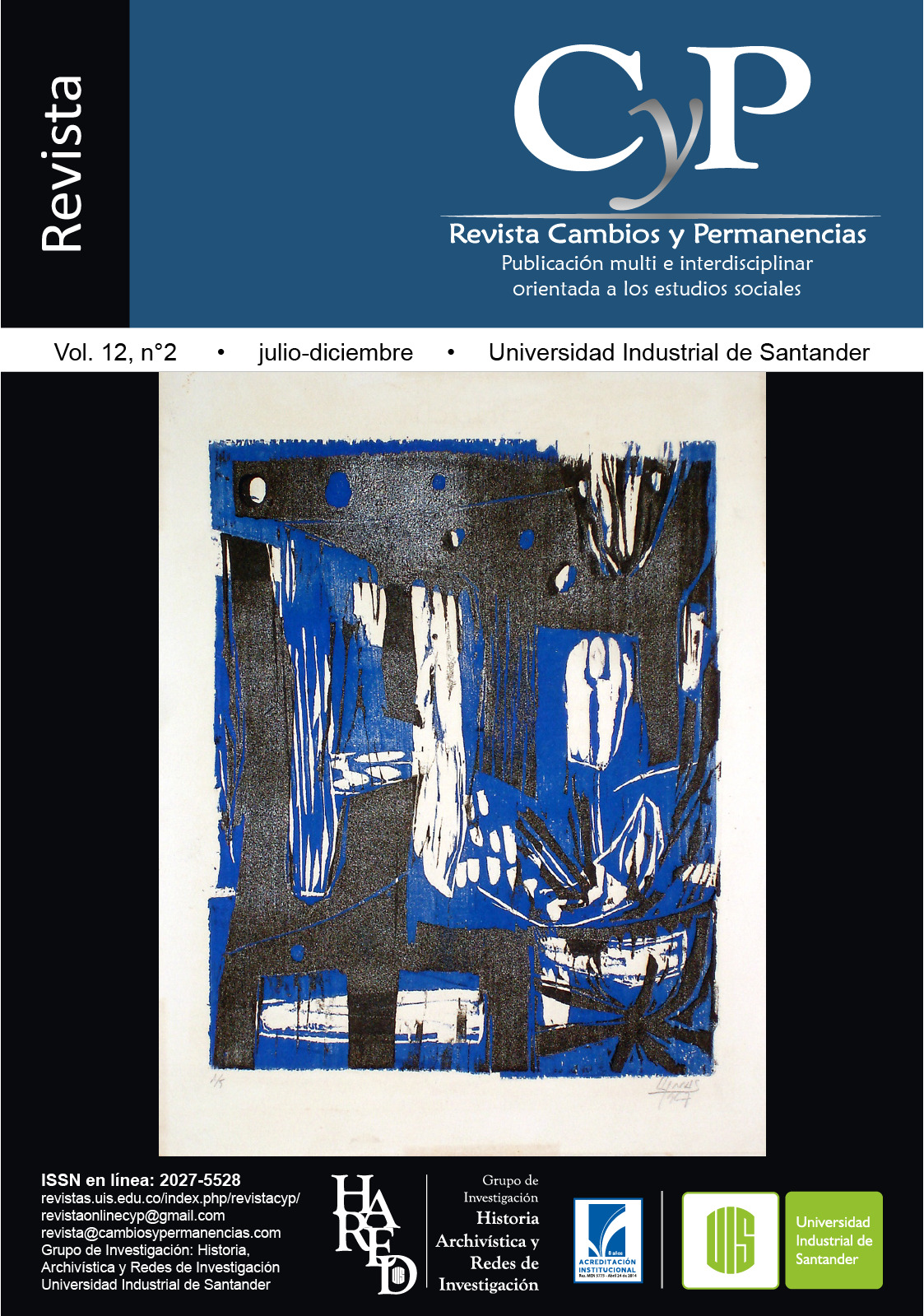Precision digital social mapping for the search for missing persons in Guaviare, Colombia
Published 2021-12-13
Keywords
- Enforced disappearance,
- Guaviare,
- Digital Social Mapping,
- Victims
How to Cite
Copyright (c) 2021 Revista Cambios y Permanencias

This work is licensed under a Creative Commons Attribution 4.0 International License.
Abstract
The precision digital social cartography for the search of disappeared persons and the location of places of irregular disposal of corpses in Guaviare, as well as, the strategy of dialogue between knowledges. Firstly, it allows an active participation of criminal experts, scientists, investigators, validators and victims. Secondly, it permits to document cases of missing persons (PD) (Acronym from Spanish). Thirdly, identification of places, where corpses are disposed. In this way, creating an atmosphere of trust and thoroughness resulting from the anonymization of the sources and identity of the persons providing information, taking as a starting point the humanitarian character of the location and the possible recovery.
This article reports the preliminary results about the implementation of the methodology in two regions; Guaviare and Meta. Where the cases have been documented in the SIRDEC Information System for Bodies and Missing People (acronym from Spanish) with the following distribution 153 in San José del Guaviare, 110 in Calamar, and 78 in El Castillo (Meta).
Therefore, social mapping becomes a precision tool that articulates the traditional knowledge of communities, the processes of technological application and the documentation of cases to ensure the search for missing persons, unidentified persons and provide for the search of sites, graves, and other irregular burial sites.
Consequently, this methodology is a process to develop and research that human rights seekers and defenders must improve with help from academy, science, and dialogues of knowledge. Which might be applied in the context of the fight against impunity and crimes such as the enforced disappearance of persons.
Downloads
References
- Referencias bibliográficas
- Archila, M. (2018). Conferencia magistral. Diálogo Internacional de Saberes sobre Desaparición Forzada. Bogotá, Colombia.
- Cala, P., y Raad, D. (2014). San José del Guaviare: Urge exhumar la memoria. Revista Trochas de Memoria, 5(500), 19-46.
- Centro Nacional de Memoria Histórica (2018). Desaparición forzada. Balance de la contribución del CNMH al esclarecimiento histórico. Bogotá, Colombia: CNMH.
- CINEP. (2004). 29 caso. Revista Noche y Niebla.
- Escudero, H. (2012). Cartografía Social. Comodoro Rivadavia, Argentina: Universitaria de la Patagonia. Recuperado de http://www.margen.org/Libro1.pdf
- Habegger, S. (S. F.). El poder de la Cartografía Social en las prácticas contrahegemónicas o La Cartografía Social como estrategia para diagn osticar nuestro territorio. Recuperado de http://beu.extension.unicen.edu.ar/xmlui/bitstream/handle/123456789/365/Habegger%20y%20Mancila_El%20poder%20de%20la%20cartografia%20social.pdf?sequence=1&isAllowed=y
- Linares, C. (2018). Labor humanitaria de búsqueda de los desaparecidos en Colombia. Guía 03. Recuperado de http://coljuristas.org/documentos/tmp/guia_03.pdf
- Lora L., y Rocha J. (2016). Promoción de la innovación social a través de la utilización de metodologías participativas en la gestión del conocimiento. Promoting Social Innovation through Participatory Approaches in Knowledge Management, (25), 159-178. doi: 10/gfwppq
- Mariño, S., Godoy, M., Alfonzo, P., Acevedo, J., y Gómez Solis, L. (2012). Accesibilidad en la definición de requerimientos no funcionales. Revista Multiciencias, 12(3), 305-312. Recuperado de https://www.redalyc.org/pdf/904/90426810009.pdf
- Mora Paez, H. y Jaramillo, C. M. (2018). Aproximación a la construcción de cartografía social a través de la geomática. Recuperado de http://beu.extension.unicen.edu.ar/xmlui/handle/123456789/348
- Ortiz, M., y Borjas, B. (2008). La Investigación Acción Participativa: aporte de Fals Borda a la educación popular. Espacio Abierto, 17(4), 615-627.
- Rozo Álvarez, W., y Puerto Valdivieso, C. (2016). Una aproximación a las exhumaciones humanitarias a partir del caso Charras (Guaviare, Colombia). Criterio Jurídico Garantista, 9(15).
- Rozo W. (2017). Los sitios de disposición irregular de cadáveres en la trocha ganadera, San José del Guaviare: criterios y lineamientos para la creación de un sistema de información (Trabajo de investigación presentado a la Fundación Universidad Autónoma de Colombia como requisito para optar al título de: Magíster en ciencias penales y forenses). Fundación Universidad Autónoma de Colombia, Bogotá Colombia.
- Rozo. W. (2019). Sistematización de la experiencia Jornadas interinstitucionales de documentación de casos de desaparición de personas en el departamento del Guaviare. Documento de informe de trabajo de campo.
- Vélez Torres. (2012). Cartografía social como metodología participativa y colaborativa de investigación en el territorio afrodescendiente de la cuenca alta del río Cauca. Cuadernos de Geografía: Revista Colombiana de Geografía, 21(2)2), 59-73. Recuperado de https://revistas.unal.edu.co/index.php/rcg/article/view/25774/36770
- Villegas, R. (2000). Investigación participativa. En G. Pérez Serrano (2000), Modelos de investigación cualitativa en la Educación Social y Animación Socio Cultural. Aplicadas prácticas. Madrid, España: Nancea.
